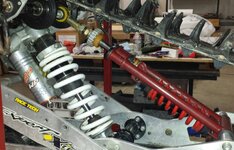Spent some time in the shop looking at my rear A arm and the hammering it takes in use. This hammering is why the plastic bushings have all grenaded. The fix from MT is a metal bushing, but this does not address the issue, only partly addresses the symptom.
What i noticed is that the billet T pivot, which many have snapped, had score marks on the shoulder where it's been making angry love to the A arm steel. This is what is hammering the plastic bushings. But also hammers the aluminum. And that force travels up to guess what? The idler shaft that is getting broken. So here is a problem area that must be addressed.
So I figured the shoulder needs removed to allow more stroke, and also smooth the transition because a stress-riser in this area is a bad thing.
So I cut the shoulder off and reinstalled it. Then I checked the movement on this pivot and discovered that all I've done is increase the range before the hammering starts.
https://youtu.be/KN3PxAK_RMk
https://youtu.be/9IGGU6DK2Qo
Here's that "dirt bike feel" in action
What's funny is I haven't felt any harshness from this binding while riding.
So I believe that limited straps are required here to eliminate hammering on compression at least. A nice fellow from Idaho confirmed this on the phone yesterday and he said it works fantastic on his. So I guess this isn't a tip, trick or a fix just yet.













